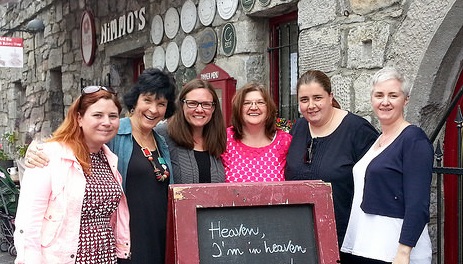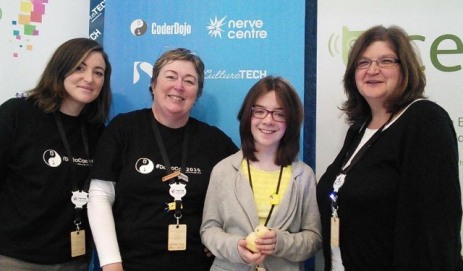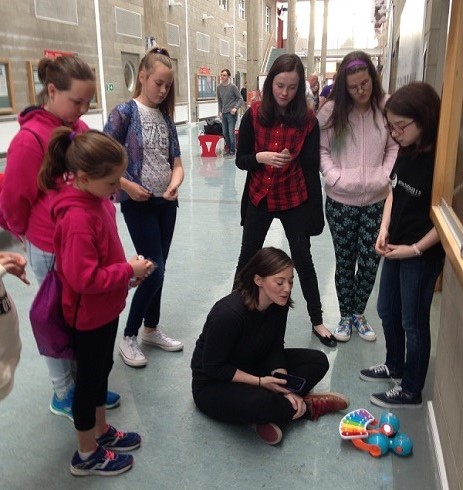I’ve followed the BETT story of many #edchatie teachers on Twitter over the past few years jealously. It never seemed to work out that I too could go – that is until this year. Anyone who had previously been, extolled the virtues of going to BETT, and I wondered if it could possibly live up to the hype. Having now seen it for myself, I can categorically state that it did! BETT runs over four days and I went for the last two – the Friday which included a TeachMeet and the Saturday.

I had done a little bit of preparation before making the trip but it was of the download the app and the material variety rather than actually engaging with what was available. On the Thursday night I had a look at the talks and made a rough plan of what talks I wanted to see over the following few days. I figured that from an exhibitor point of view I would just wait and see what caught my eye. It turned out that I was completely unprepared for the wide variety of exhibitors that were at BETT. There was something for everyone, but I have to admit that I found the sheer volume a bit overwhelming, particularly on the Friday. As a result I made the decision to focus almost entirely on the talks. There was plenty to choose from with more than 50 talks on Friday alone!
First up for me was Arvin Ross talking about Digital Storytelling. Arvin gave a very engaging talk and shared his pick of the best apps to help with Storytelling

The Puppet Pals app also got a mention as a great app for Story telling.
Next choice for me was Ed Cooke talking about memory techniques and how they can be used to super power student learning. What struck me was how Ed got us all to remember 20 seemingly unrelated objects by weaving them into a story. Seeing how we remembered the items both backwards and forwards was a revelation. The final surprise was revealed when Ed told us that the 20 objects were in fact elements from the Periodic Table (the balloon representing Helium etc.). Check out memrise.com for more information.
At lunchtime I decided to go to the Flipped Learning session in the main arena. The session was given by Aaron Sams and Jon Bergmann, co-founders of the Flipped Classroom. I’ve been toying with the idea of introducing some aspects of flipped learning so it was great to hear about how others have made it work and what their students have gained from it. One of my takeaways from this session, was that the Flipped Classroom does not dehumanise the classroom, but rather that it places the teacher even more at the centre of the class as the focus has changed. The very strong message was the importance of relationships in the classroom, a point that was reinforced in the drawings that were to be found on the outside of the BETT arena

After a quick bite to eat it was time to go to Doug Belshaw’s masterclass on improving digital literacy among staff and students. What I loved about Doug’s talk was that it was more of a conversation starter than a masterclass as it prodded us to consider a broad range of literacies as opposed to a single one.

I particularly loved this proverb

I know which is my preference – what’s yours?

My final session of the day was Sir Ranulph Fiennes’ talk – ‘Beyond the Limits’. It was billed as an Inspirational Keynote and boy did it deliver! Hearing Sir Ranulph recount his tales of crossing both the Artic and the Antartic was active learning at it’s very best. It’s great to get a chance to hear people of this calibre speak at events like this. I love to hear people from outside the educational domain speak at educational events as they often have a different perspective which challenges up to think differently.

By this stage it was time for me to do a talk of my own. I had been asked to speak at the OCR stand about CoderDojo with Mags Amond. I wasn’t sure how it was going to work as it wasn’t a scheduled talk – it was more a case of start talking and hope that people would stop and listen. It turned out to be a more enjoyable experience than I had imagined – Mags and I worked well together and a good few people stopped and listened.
The rest of Friday was taken up with the TeachMeet which I’ve previously written about here and the TeachEat, an opportunity to chat and mingle and generally relax after a long, busy day.
First up on Saturday was ‘Learning Science with iPads’ with Ed Walsh.
 I was very interested in the next session ‘Analytical and predictive primary math teaching in Finland. Finland is often held up as an exemplar regarding education so I was curious as to what we might find out from this talk. I was a bit taken aback to find that the same issues around Maths education are to be found there
I was very interested in the next session ‘Analytical and predictive primary math teaching in Finland. Finland is often held up as an exemplar regarding education so I was curious as to what we might find out from this talk. I was a bit taken aback to find that the same issues around Maths education are to be found there
 We heard about the emphasis on autonomy and teacher training that are so central to the Finnish education system but also the issues around integrating ICT into the system
We heard about the emphasis on autonomy and teacher training that are so central to the Finnish education system but also the issues around integrating ICT into the system

It’s good to get this viewpoint and to see that teachers in many different countries are dealing with similar issues to the ones we face in this country.
 One of the last sessions I went to was the Stemettes Hackathon. It was such an enjoyable session and reminded me a lot of CoderDojo. I loved how Anne Marie led the hackathon and used the example of making a jam sandwich to demonstrate the concept of an algorithm with the girls who had come to work on developing websites in real time.
One of the last sessions I went to was the Stemettes Hackathon. It was such an enjoyable session and reminded me a lot of CoderDojo. I loved how Anne Marie led the hackathon and used the example of making a jam sandwich to demonstrate the concept of an algorithm with the girls who had come to work on developing websites in real time.

The future is safe with these kinds of initiatives …
And so we come to the last session of BETT2014 – ‘The Great Education Debate – can technology ever replace the classroom?’ We heard short presentations from the panelists : Tim Rylands who stole the show in my view, Anne Lise Kjaer, Maggie Philbin, Ian Bauckham and Simon Milner. I learned a new term from Tim – the elsie as opposed to the selfie.
 One of the ideas that was reinforced during the closing session was the importance of the teacher in the classroom while recognising the power of technology to hook students and to facilitate learning. It’s good to see that the emphasis on technology in education is entirely about its integration into the classroom, as an aid to teaching and learning, and not about it’s use for it’s own sake. Plenty of food for thought until next year …
One of the ideas that was reinforced during the closing session was the importance of the teacher in the classroom while recognising the power of technology to hook students and to facilitate learning. It’s good to see that the emphasis on technology in education is entirely about its integration into the classroom, as an aid to teaching and learning, and not about it’s use for it’s own sake. Plenty of food for thought until next year …
 While I’ve focused in this post on the talks I attended, the most important aspect of attending conferences for me is the opportunity to chat to other educators. I was fortunate to spend the weekend at BETT in the company of Helen, Bianca, Mags and Kathleen as well as many of the #edchatie folk who made the trip to BETT. Chatting about what you are hearing and seeing helps to process all of the information that is being thrown in your direction. I definitely get more from a conference when I get a chance to discuss it with others. It’s also good to hear about the work going on in classrooms across Ireland and beyond … hearing Bianca talking about “her” kids and the amazing projects that they are working on, hearing Mags and Kathleen talk about the importance of the relationships they have with their students, hearing Helen talk about the success of the How I Learn book all serve to invigorate you in what you are doing in you own classroom. It’s also amazing to get the chance to catch up with people like Steve Bunce, Doug Belshaw, Helen Keegan, Dughall McCormack, Joe Dale and so many more. It’s only when you get a chance to reflect on the overall experience of BETT that you begin to realise just how much you get from attending! I’m looking forward to BETT 2015 already 🙂
While I’ve focused in this post on the talks I attended, the most important aspect of attending conferences for me is the opportunity to chat to other educators. I was fortunate to spend the weekend at BETT in the company of Helen, Bianca, Mags and Kathleen as well as many of the #edchatie folk who made the trip to BETT. Chatting about what you are hearing and seeing helps to process all of the information that is being thrown in your direction. I definitely get more from a conference when I get a chance to discuss it with others. It’s also good to hear about the work going on in classrooms across Ireland and beyond … hearing Bianca talking about “her” kids and the amazing projects that they are working on, hearing Mags and Kathleen talk about the importance of the relationships they have with their students, hearing Helen talk about the success of the How I Learn book all serve to invigorate you in what you are doing in you own classroom. It’s also amazing to get the chance to catch up with people like Steve Bunce, Doug Belshaw, Helen Keegan, Dughall McCormack, Joe Dale and so many more. It’s only when you get a chance to reflect on the overall experience of BETT that you begin to realise just how much you get from attending! I’m looking forward to BETT 2015 already 🙂






![IMG_7837[1]](https://pamobriensblog.files.wordpress.com/2015/10/img_78371.jpg?w=538)


![IMG_1634[1]](https://pamobriensblog.files.wordpress.com/2014/07/img_16341.jpg?w=538&h=538)
![IMG_1638[1]](https://pamobriensblog.files.wordpress.com/2014/07/img_16381.jpg?w=538&h=538)




































